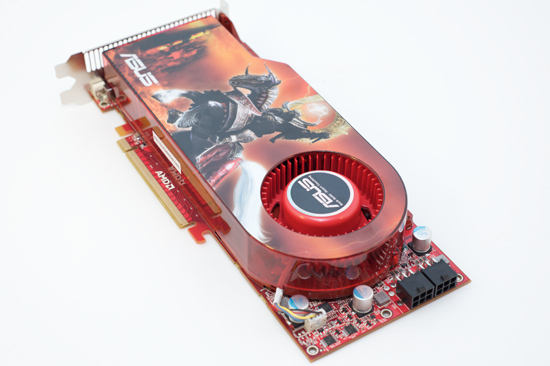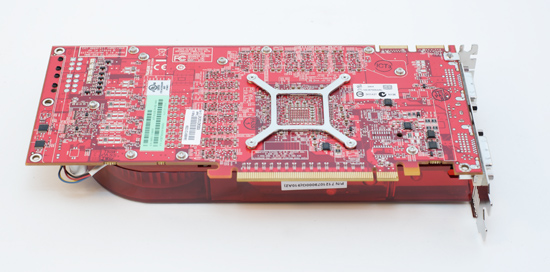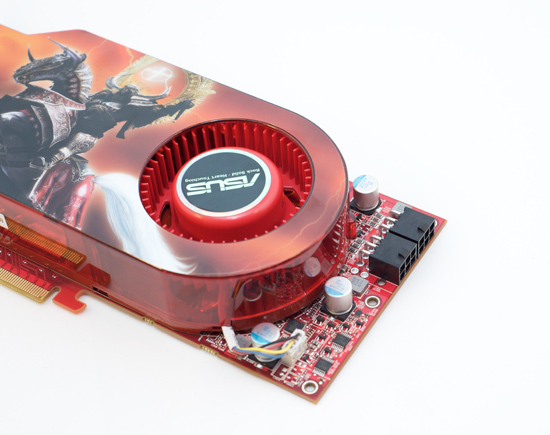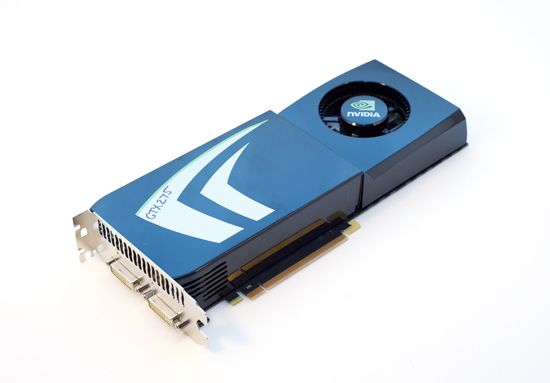ATI Radeon HD 4890 vs. NVIDIA GeForce GTX 275
by Anand Lal Shimpi & Derek Wilson on April 2, 2009 12:00 AM EST- Posted in
- GPUs
The Cards and The Test
In the AMD department, we received two cards. One was an overclocked part from HIS and the other was a stock clocked part from ASUS. Guess which one AMD sent us for the review. No, it's no problem, we're used to it. This is what happens when we get cards from NVIDIA all the time. They argue and argue for the inclusion of overclocked numbers in GPU reviews when it's their GPU we're looking at. Of course when the tables are turned so are the opinions. We sincerely appreciate ASUS sending us this card and we used it for our tests in this article. The original intent of trying to get a hold of two cards was to run CrossFire numbers, but we only have one GTX 275 and we would prefer to wait until we can compare the two to get into that angle.



The ASUS card also includes a utility called Voltage Tweaker that allows gamers to increase some voltages on their hardware to help improve overclocking. We didn't have the chance to play with the feature ourselves, but more control is always a nice feature to have.

For the Radeon HD 4890 our hardware specs are pretty simple. Take a 4870 1GB and overclock it. Crank the core up 100 MHz to 850 MHz and the memory clock up 75 MHz to 975 MHz. That's the Radeon HD 4890 in a nutshell. However, to reach these clock levels, AMD revised the core by adding decoupling capacitors, new timing algorithms, and altered the ASIC power distribution for enhanced operation. These slight changes increased the transistor count from 956M to 959M. Otherwise, the core features/specifications (texture units, ROPs, z/stencil) remain the same as the HD4850/HD4870 series.
Most vendors will also be selling overclocked variants that run the core at 900 MHz. AMD would like to treat these overclocked parts like they are a separate entity altogether. But we will continue to treat these parts as enhancements of the stock version whether they come from NVIDIA or AMD. In our eyes, the difference between, say, an XFX GTX 275 and an XFX GTX 275 XXX is XFX's call; the latter is their part enhancing the stock version. We aren't going to look at the XFX 4890 and the XFX 4890 XXX any differently. In doing reviews of vendor's cards, we'll consider overclocked performance closely, but for a GPU launch, we will be focusing on the baseline version of the card.
On the NVIDIA side, we received a reference version of the GTX 275. It looks similar to the design of the other GT200 based hardware.

Under the hood here is the same setup as half of a GTX 295 but with higher clock speeds. That means that the GTX 275 has the memory amount and bandwidth of the GTX 260 (448-bit wide bus), but the shader count of the GTX 280 (240 SPs). On top of that, the GTX 275 posts clock speeds closer to the GTX 285 than the GTX 280. Core clock is up 31 MHz from a GTX 280 to 633 MHz, shader clock is up 108 MHz to 1404 MHz, and memory clock is also up 108 MHz to 2322. Which means that in shader limited cases we should see performance closer to the GTX 285 and in bandwicth limited cases we'll still be faster than the GTX 216 because of the clock speed boost across the board.
Rather than just an overclock of a pre-existing card, this is a blending of two configurations combined with an overclock from the two configurations from which it was born. And sure, it's also half a GTX 295, and that is convenient for NVIDIA. It's not just that it's different, it's that this setup should have a lot to offer especially in games that aren't bandwidth limited.
That wraps it up for the cards we're focusing on today. Here's our test system, which is the same as for our GTS 250 article except for the addition of a couple drivers.
The Test
| Test Setup | |
| CPU | Intel Core i7-965 3.2GHz |
| Motherboard | ASUS Rampage II Extreme X58 |
| Video Cards | ATI Radeon HD 4890 ATI Radeon HD 4870 1GB ATI Radeon HD 4870 512MB ATI Radeon HD 4850 NVIDIA GeForce GTX 285 NVIDIA GeForce GTX 280 NVIDIA GeForce GTX 275 NVIDIA GeForce GTX 260 core 216 |
| Video Drivers | Catalyst 8.12 hotfix, 9.4 Beta for HD 4890 ForceWare 185.65 |
| Hard Drive | Intel X25-M 80GB SSD |
| RAM | 6 x 1GB DDR3-1066 7-7-7-20 |
| Operating System | Windows Vista Ultimate 64-bit SP1 |
| PSU | PC Power & Cooling Turbo Cool 1200W |










294 Comments
View All Comments
evilsopure - Thursday, April 2, 2009 - link
Update: I guess Anand was making his updates while I was making my post, so the "marginal leader at this new price point of $250" line is gone and the Final Words actually now reflect my own personal conclusion above.Anand Lal Shimpi - Thursday, April 2, 2009 - link
I've updated the conclusion, we agree :)-A
SiliconDoc - Monday, April 6, 2009 - link
You agree now that NVidia has moved their driver to the 2650 rez to win, since for months on end, you WHINED about NVidia not winning at the highest rez, even though it took everyting lower.So of COURSE, now is the time to claim 2650 doesn't matter much, and suddenly ROOT for RED at lower resolutions.
It Nvidia screws you out of cards again, I certainly won't be surprised, because you definitely deserve it.
Thanks anyway for changing Derek's 6 month plus long mindset where only the highest resolution mattered, as he had been ranting and red raving how wonderful they were.
That is EXACTLY WHY his brain FARTED, and he declared NVidia the top dog - it's how he's been doing it for MONTHS.
So good job there, you BONEHEAD - you finally caught the bias, just when the red rooster cards FAILED at that resolution.
Look in the mirror - DUMMY - maybe you can figure it out.
7Enigma - Thursday, April 2, 2009 - link
Check the article again. Anand edited it and it is now very clear and concise.7Enigma - Thursday, April 2, 2009 - link
Bah, internet lag. Ya got there first.... :)sublifer - Thursday, April 2, 2009 - link
As I predicted elsewhere, they probably should have named this new card the GTX 281. In almost every single benchmark and resolution it beats the 280. In one case it even beat the 285 somehow./Gripe
That said, Go AMD! I wanna check other sites and see if they benched with the card highly over-clocked. One site got 950 core and 1150 memory easily but they didn't include it on the graphs :(
Anand Lal Shimpi - Thursday, April 2, 2009 - link
Hey guys, I just wanted to chime in with a few fixes:1) I believe Derek used the beta Catalyst driver that ATI gave us with the 4890, not the 8.12 hotfix. I updated the table to reflect this.
2) Power consumption data is now in the article as well, 2nd to last page.
3) I've also updated the conclusion to better reflect the data. What Derek was trying to say is that the GTX 275 vs. 4890 is more of a wash at 2560 x 1600, which it is. At lower than 2560 x 1600 resolutions, the 4890 is the clear winner, losing only a single test.
Thank you for all the responses :)
Take care,
Anand
7Enigma - Thursday, April 2, 2009 - link
Thank you Anand for the update and the article changes. I think that will quell most of the comments so far (mine included).Could you possibly comment on the temps posted earlier in the comments section? My question is whether there are significant changes with the fan/heatsink between the stock 4870 and the 4890. The idle and load temps of the 4890 are much lower, especially when the higher frequency is taken into consideration.
Also a request to describe the differences between the 4890 and the 4870 (several comments allude to a respin that would account for the higher clocks, lower temp, different die size).
Thank you again for all of your hard work (both of you).
Warren21 - Thursday, April 2, 2009 - link
Yeah, I would also second a closer comparison between RV790 and RV770, or at least mention it. It's got new power phases, different VRM (7-phase vs 5-phase respectively), slightly redesigned core (AT did mention this) and features a revised HS/F.VooDooAddict - Thursday, April 2, 2009 - link
I was very happy to see the PhysX details. I'd started worrying I might be missing out with my 4870. It's clear now that I'm not missing out on PhysX, but might be missing out on some great encoding performance wiht CUDA.I'll be looking forward to your SLI / Crossfire followup. Hoping to see some details about peformance with ultra high Anti-Aliasing that's only available with SLI/Crossfire. I used to run Two 4850s and enjoyed the high-end Edge Antialiasing. Unfortunetly the pair of 4850's were a too much heat in a tiny shuttle case so I had to switch out to a 4870.
Your review reinforced something that I'd been feeling about the 4800s. There isn't much to complain about when running 1920x1200 or lower with modest AA. They seem well positioned for most gamers out there. For those out there with 30" screens (or lusting after them, like myself)... while the GTX280/285 has a solid edge, one really needs SLI/Crossfire to drive 30" well.